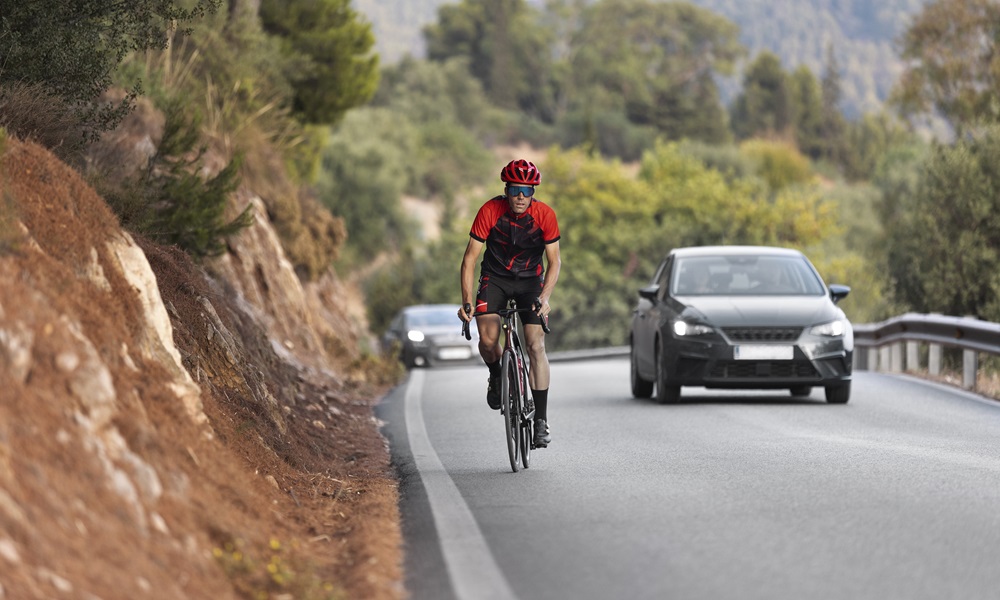As the roads in New South Wales (NSW) become increasingly shared between drivers and cyclists, it’s crucial for both parties to understand how to coexist safely and respectfully. This blog offers practical beginner road cycling tips for both cyclists and drivers to ensure everyone can navigate NSW roads safely.

Tips for Drivers: Sharing the Road with Cyclists
1. Give Cyclists Space
It is essential for drivers to allow at least 1.5 metres of clearance when overtaking cyclists. This distance is crucial for ensuring cyclists can safely manoeuvre around obstacles such as potholes, debris, or sudden changes in road conditions.
In many parts of NSW, this is not just courteous; it’s the law, particularly when travelling over 60 km/h where the minimum passing distance increases to 2 metres.
2. Check Before Turning
Before turning or changing lanes, it’s vital to thoroughly check your mirrors and blind spots for cyclists. Cyclists may be closer than they appear or positioned in areas that are not immediately visible.
This is especially important in heavy traffic or at busy intersections, where cyclists might be navigating between lanes or approaching quickly from behind. Making this a habit can prevent many potential accidents.
3. Be Patient
Understanding and patience are key when sharing the road with cyclists. Cyclists often travel slower than motorised traffic and may need additional time to get through intersections or up hills.
Honking, tailgating, or aggressive manoeuvres can intimidate cyclists and lead to dangerous situations. Patience not only helps in preventing accidents but also contributes to a more respectful and harmonious sharing of the road.
These practices are not just recommendations but part of being a responsible driver on NSW roads. Adhering to these tips can significantly enhance safety for both cyclists and drivers, promoting a cooperative environment on the road.
Tips for Cyclists: Staying Safe Amongst Vehicles
1. Follow the Road Rules
As a cyclist, adhering to road rules is fundamental for your safety and the safety of others. This means obeying traffic lights, using designated bike lanes where available, and signalling turns well in advance. Stopping at red lights and stop signs is not only a legal requirement but also a crucial practice in preventing accidents.
Familiarising yourself with specific cycling regulations in NSW can enhance your safety and ensure smoother interactions with motor vehicles.
2. Make Yourself Visible
Visibility is a key factor in cycling safety, particularly under conditions of low light or bad weather when the risk of accidents increases.
Wear brightly coloured or reflective clothing to make yourself more visible to drivers. Equip your bike with lights and reflectors: a white light at the front and a red light at the back, as well as reflective strips on your helmet and pedals. These measures significantly decrease the chance of being overlooked by motorists.
3. Communicate with Drivers
Effective communication with drivers can dramatically reduce the risk of accidents. Always signal your intentions clearly using hand signals before turning or changing lanes. Where possible, make eye contact with drivers at intersections or when making significant manoeuvres.
This not only ensures that drivers are aware of your presence and intentions but also helps establish a mutual understanding and respect on the road, fostering safer interactions between cyclists and drivers.
Cycling Safety Tips: Mutual Respect and Understanding
Be Aware of Each Other’s Needs
Drivers should understand that cyclists are more vulnerable in crashes, while cyclists should be aware that drivers may not always be able to see them. Mutual respect and understanding can greatly enhance safety for everyone.
Education and Awareness
Both cyclists and drivers should educate themselves about the specific challenges and best practices for road sharing. Local councils often offer resources and workshops on road safety.
The Importance of Insurance
Lastly, it’s vital for all NSW drivers to remember that having a valid Greenslip or CTP insurance is mandatory to drive on NSW roads. This insurance helps protect drivers and cyclists alike in the event of an accident.
Using Greenslips 4 Earth’s CTP Calculator
For drivers, ensuring you have the right CTP insurance is crucial. Greenslips 4 Earth’s CTP Calculator can help you easily compare Greenslip prices from leading insurers, ensuring that you get the best deal possible and remain covered while sharing the road with cyclists.
For more information on safe driving and cycling practices and to compare Greenslip prices, visit our blog. By following these tips and fostering an environment of respect and caution, we can make NSW roads safer for everyone, whether they are behind the wheel or on two wheels.





